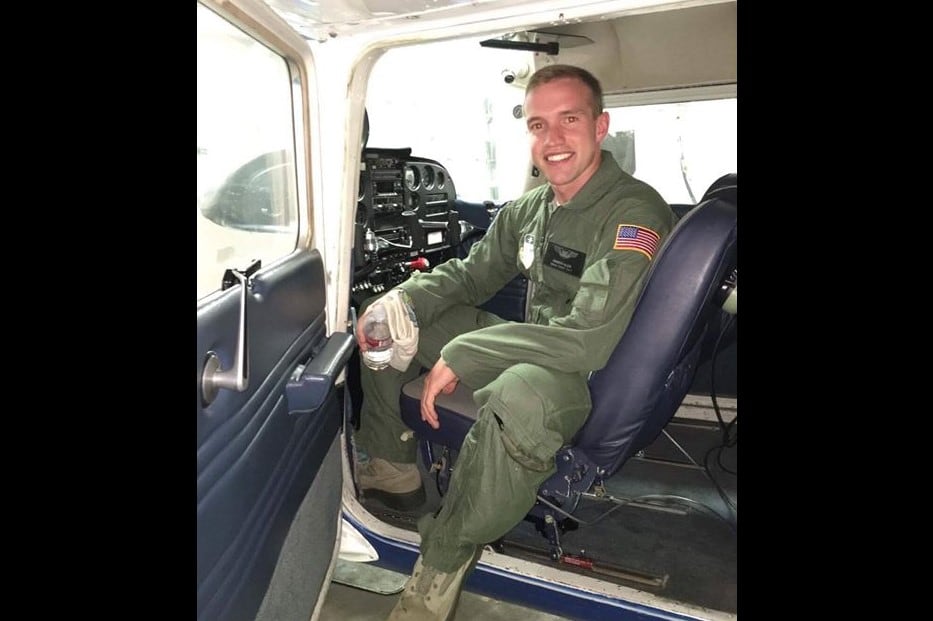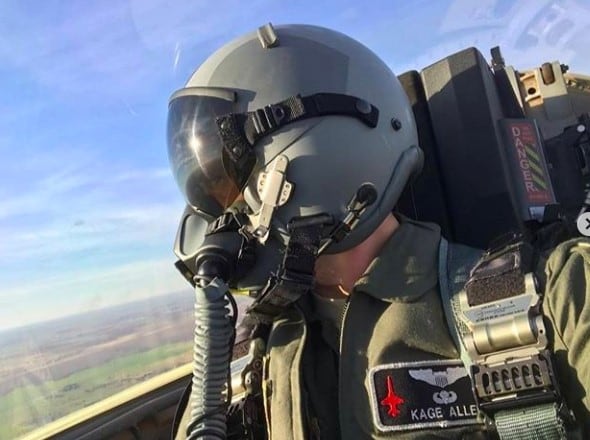The F-15C pilot who died in a crash in the ocean near England earlier this year was “fixated” on trying to intercept a simulated adversary, flying aggressively, and disoriented due to poor weather, an investigation found.
1st Lt. Kenneth “Kage” Allen, 27, died the morning of June 15 when his fighter crashed into the North Sea, east of the United Kingdom, during a training flight. He was the assistant chief of weapons and tactics for the 493rd Fighter Squadron, part of the 48th Fighter Wing at RAF Lakenheath in England, where he began serving in February.
Allen was one of four fighters in a defensive counter-air training mission, trying to protect an asset — the British aircraft carrier HMS Queen Elizabeth — against six other F-15Cs serving as adversaries, according to the report released Monday. He was originally supposed to fly as part of the “Red Air” adversary team, but was pulled to the “Blue Air” flight to replace an ill pilot.
The morning was overcast, with cloud layers between 9,000 and 14,000 feet, and from 1,000 to 4,000 feet, the report said. The other pilots testified that multiple cloud layers made the horizon “difficult if not impossible to discern below 9,000 feet.”
As a result of the cloudy conditions, the sortie was conducted using Instrument Meteorological Conditions, or IMC, rules, which impose pitch limitations of 15 degrees and bank limitations of 60 degrees.
The investigator concluded that once Allen exited the clouds at 10,000 feet during the attempted intercept, “the reduced visibility below the cloud layer and lack of a discernable horizon” left him spatially disoriented and unable to tell his aircraft was pitched low and losing altitude.

The report also concluded that Allen likely did not check his instruments during the rapid-fire series of events before his crash, and therefore didn’t realize he had become so disoriented while “aggressively maneuvering the aircraft” without horizon, sky or ocean to orient him.
“This unfortunate accident is yet another reminder of the inherent risks airmen take on a daily basis to ensure the successes of our Air Force,” Gen. Jeff Harrigian, commander of U.S. Air Forces in Europe-Air Forces Africa, said in a release. “Lt. Allen was an outstanding officer and a tremendous asset to the team. No words can compensate for such a painful and sudden loss.”
“The loss of an airman is never easy, and this aircraft accident was no exception,” wing commander Col. Jason Camilletti said in the release. “Our Liberty Wing community, especially the Reapers of the 493rd Fighter Squadron, was truly touched by the tremendous outpouring of support from families, friends and partners around the globe in our time of grieving.”
Allen, an Air Force Academy graduate, is survived by his wife, Hannah, and his parents. Hannah Allen posted heartfelt tributes to her late husband on social media, including a video of him playing guitar and singing to her shortly before he died. They had just gotten married Feb. 20.

Allen’s flight took off at about 8:47 a.m. At about 9:25 a.m., Allen’s flight converged with the Red Air adversary flight, and shifted to more restrictive maneuvering as a result of the poor weather. Soon afterwards, Allen’s flight lead told him to turn hard right back to the west, and look for an adversary at a lower altitude.
Allen, who was at 20,300 feet, spotted the adversary to his west at 5,000 feet and began descending as he approached. He fired a simulated air-to-air missile, turned further right until he was going northwest, and kept descending at about 16,000 feet per minute.
Allen turned left, to the west, and slowed his descent rate to 7,200 feet per minute — but he was still descending. He radioed in that he had fired a simulated missile at the adversary, but was told that it probably missed.
Allen, who at that point was at 12,000 feet, started to roll left to further pursue the other fighter, descending at 15,800 feet per minute. The report said other pilots in his flight had programmed their fighters’ altitude warnings to go off at between 10,000 and 12,500 feet, but it is unknown where Allen had set his altitude warning.
He stopped the turn, pitched his nose further down, and his descent accelerated to 22,800 feet per minute, the report said. Allen’s airspeed also increased as he descended through 10,200 feet, and then to 4,000 feet, where he breached the minimum training floor.
RELATED

Allen appears to have tried to recover from his dive in the last few seconds, pulling the fighter to nearly wings-level, but was unsuccessful. He hit the water at high speed at 9:27 a.m., about a minute and a half after he began trying to engage the other F-15. Allen is believed to have died instantly, and the F-15 was completely destroyed. The report said no evidence was found he started the ejection sequence.
Allen was a hard-working but “inexperienced” F-15C pilot who graduated from the fighter’s formal training unit on Jan. 17 and qualified as a wingman on May 20, the report said. He had 270.7 total military flying hours, including 64.3 hours in the C and D variants of the F-15, and 151.7 simulator hours in the F-15C.
He was well-regarded, and had a reputation in his squadron for being a hard worker who put a lot of effort into studying and preparing for his missions. He also received high marks for his performance in the FTU.
The investigator considered whether Allen may have lost consciousness before impact due to the high acceleration. But the report said a healthy individual, as Allen was, would typically have to to accelerate to 9 G-forces for at least five seconds before losing consciousness. Allen briefly hit 8.2 G-forces for just 0.7 seconds as he tried to pull out of his dive about 1,000 feet above the water, and appears to have continued to control his aircraft until the end, making a loss of consciousness unlikely.
Stephen Losey is the air warfare reporter for Defense News. He previously covered leadership and personnel issues at Air Force Times, and the Pentagon, special operations and air warfare at Military.com. He has traveled to the Middle East to cover U.S. Air Force operations.





